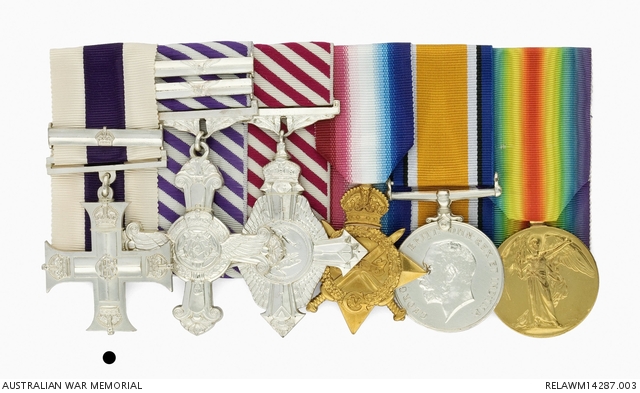| Place | Middle East: Ottoman Empire, Palestine |
|---|---|
| Accession Number | RELAWM14287.003 |
| Collection type | Heraldry |
| Object type | Award |
| Maker |
Unknown |
| Place made | United Kingdom |
| Date made | c 1917 |
| Conflict |
First World War, 1914-1918 |
Military Cross and Bar: Lieutenant Ross Macpherson Smith, Australian Flying Corps, AIF

Military Cross (Geo V) and bar. Inscribed with recipient's details on reverse.
Military Cross (MC) awarded to Lieutenant Ross Macpherson Smith on 27 March 1917 for 'Conspicuous gallantry and devotion to duty when his pilot descended to the rescue of an officer who had been forced to land. On landing he held the enemy at bay with his revolver, thus enabling his pilot to rescue the officer and to safely fly away his machine'.
Smith was awarded a bar to his MC on 22 December 1917. His recommendation reads: 'On the 27th November, 1917, this Officer was one of two pilots who carried out a remarkable series of photographs, completely covering an important area of 45 square miles north west of JERUSALEM in one flight. On 11th December, 1917, this Officer attacked the Jordan Bridge with bombs dropped from a low height. His work throughout has been characterised by consistent gallentry and his photography has been invaluable.'
Smith had enlisted in the AIF in August 1914. Initially serving in B Squadron, 3rd Light Horse Regiment as a sergeant, he was promoted to regimental sergeant major, and then commissioned 2nd lieutenant at Gallipoli in September 1915. In March 1916 he was promoted to lieutenant before being transferred to the 1st Light Horse Brigade Machine Gun Squadron a few months later. He was transferred to the Australian Flying Corps in October 1916 and was promoted to captain in November 1917. In late 1918 he was detached from 1 Squadron AFC for special duty with the Royal Air Force in connection with a flight between Egypt and India. In early 1919 he reconnoitred a route between India and Australia and in July 1919 was attached to 31 Squadron RAF in India.
Smith was knighted in December 1919 for successfully flying from England to Australia within 30 days. His appointment with the AIF was terminated in May 1920. Sir Ross Smith was killed in England on 13 April 1922 when the Vickers Viking amphibian he was test flying spun into the ground from 305 metres. His body was repatriated and he is buried in the North Road Anglican cemetery, Adelaide.
Share this page
Related information
Conflicts
Subjects
People
Related Objects
- Distinguished Flying Cross with two bars: Captain Ross Macpherson Smith, Australian Flying Corps, AIF
- Air Force Cross: Captain Ross Macpherson Smith, Australian Flying Corps, AIF
- Hedjaz Order of Al Nahda: Captain Sir Ross Macpherson Smith, Australian Flying Corps, AIF
- Victory Medal: Captain Ross Macpherson Smith, Australian Flying Corps, AIF
- 1914-15 Star: Sergeant Ross Machpherson Smith, 3rd Light Horse Regiment, AIF
- British War Medal 1914-20: Captain Ross Macpherson Smith, Australian Flying Corps, AIF
- KBE neck decoration: Captain Sir Ross Macpherson Smith, Australian Flying Corps, AIF
- KBE Breast Star: Captain Sir Ross Macpherson Smith, Australian Flying Corps, AIF